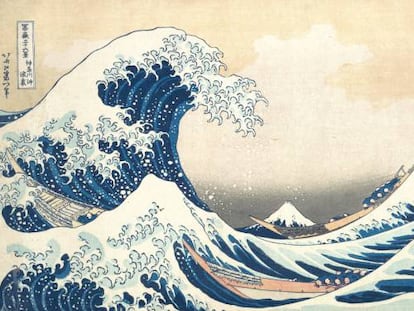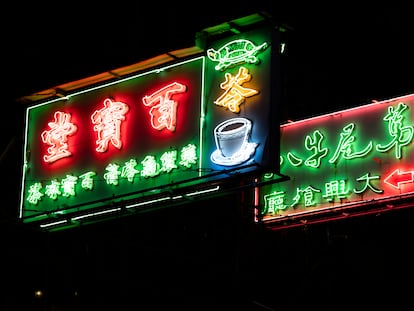Mauro Ketlun, the sculptor who shaped Leo Messi with recycled trash
The artist, who defines himself as a ‘treasure rescuer,’ recently exhibited three of his works at the Louvre Museum. ‘Messi knows what it means to bounce back and recycle in life. It was my way of paying homage to him’
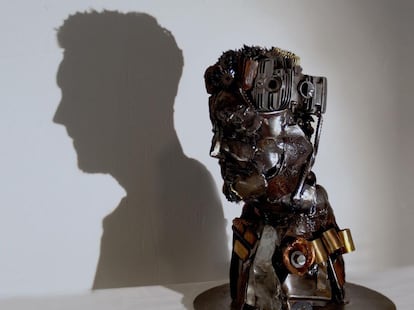
In Buenos Aires, the sun is setting. The garbage truck is hungrily prowling the streets. The dumps are overflowing. It is the appointed time. The gates open and a voice stops the crusher. “Can I take that broken chair?” asks the 49-year-old sculptor Mauro Ketlun. The scene is systematically repeated every day in other blocks and other neighborhoods of Buenos Aires. On the street, inside dump trucks, and at second-hand markets, the artist’s gaze alights on dented cans, worn fabrics, amorphous wood, and damp paper and cardboard. Also, broken toys with the story of a child engraved on them. It is gold dust in his eyes. Once in his hands, all the elements are transformed, their destiny of announced end altered.
Ketlun defines himself as a “treasure rescuer.” He has created more than 60 works using recovered and recycled materials, including a life-size bust of Lionel Messi modeled with iron, bronze, wood, and gears. Among his greatest challenges is a 1962 car that was crushed and manually reduced to 25 centimeters thick. Three of his retro-futuristic sculptures were exhibited at the Louvre Museum in 2022. He was the only Argentine chosen among the contemporary artists invited. Three artistic proposals with different focuses. Three “milestones” in his career.
In the case of the captain of the Argentina national soccer team, he wanted to make a figure that would cast Messi’s shadow. “I worked for three months creating, looking for pieces, welding, and correcting the work until I got the result I was looking for. The responsibility was enormous because he is one of the most beloved and well-known faces on the planet. Any deviation would be quickly criticized. I was very satisfied and proud of the achievement,” says Ketlun.
The sculpture contains watch parts to mark Messi’s “precision.” Metal plates from various origins representing “his reach to all cultures.” Different tools symbolizing “his multiple skills.” Parts of a bicycle in analogy with “his modesty.” Each piece of the sculpture has a meaning and carries a message. It is displayed at the headquarters of the Argentine Football Association (AFA), in Ezeiza, among other “relics” of the 2022 World Cup and 2024 Copa América champions.

“Messi knows what it means to recycle”
“Messi knows what it means to bounce back and recycle in life. It was my way of paying homage to him,” Ketlun says from his studio in the Palermo Hollywood neighborhood of Buenos Aires. The artist does too. Until the age of 40, he was regional manager of a multinational company based in Buenos Aires, where he had more than 2,000 employees under his charge. His days were measured in airplane miles traveled. Because of his position, he spent his time flying from city to city in an endless spiral. Until two tragic events changed everything.
“I was driving on the highway; I fell asleep and crashed into the guardrail. I woke up spinning around inside the car. Fortunately, I came out unharmed. That, added to the death of my sister Natalia, led me to reflect deeply on how ephemeral life is,” Ketlun reflects. On the edge of the existential abyss, he decided “not to waste any more time” and to follow his passion: recycled art. What was a hobby became his source of energy and sustenance. Thus, he opened his workshop where today he creates and teaches his technique with one premise: play as if you were five years old.
At first, his workhorses were his mini pig sculptures, in honor of two of his pets and inspiring muses: the piglets Josefina and Clementina. Over time, the recovered and recycled objects took on new forms, always with the imprint of “breaking structures.”
“I feel a deep connection with recovered objects, something like a Robin Hood instinct towards things that are going to be thrown away. I am particularly allergic, repelled by and phobic towards pessimists. Creating with waste is my way of rebelling against pessimism. Far from being tied to nostalgic concepts, it is about giving objects a second chance, guided by a positive and pragmatic conception of things and life,” says the sculptor.
From this matrix, opposed to materialistic culture, he created the clown Carambola, the genderless chef Alex and 50/50, which is half Little Red Riding Hood and half wolf. The three works were hand-molded from metal and old toys and were displayed during a three-day exhibition at the Louvre.
“It was one of the greatest achievements that one can aspire to as an artist. Some time has passed, but remembering that experience still moves me. Feeling that what you do is on par with people you admire is wonderful. Of course, my work has increased in value artistically and economically,” the sculptor says emotionally.
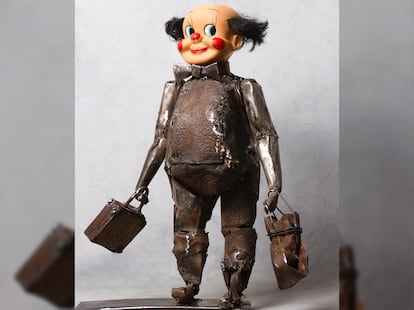
The crushed car
Disruptive. Innovative. Curious. Sensitive. According to Ketlun, these are the adjectives that best define him. The work of the 1962 car that he manually crushed to its minimum expression also speaks of him. “It is a sculpture that awakens many contradictions. I tried to put into play concepts linked to detachment from the material and tedious projects. To free oneself from the pressure of what should be,” he explains.
“I always try to innovate. My art is aligned with my own inner rhythm of permanent mobility. I change, I renew myself, I enjoy. I never know what my next work will be. Yes, the messages I want to convey are lightness of step, integrity, versatility, courage to face fears and of course, all forms of love. I am like a curious child who is always exploring,” adds the sculptor.
When asked about his next projects, the artist says that he continues “every day at every dump, every second-hand fair, every person who gives me an object before throwing it away.” His happiness, his present and his future are on that map. He is guided by a hunch: for him, the soul of objects has a second life, and the bridge is art.
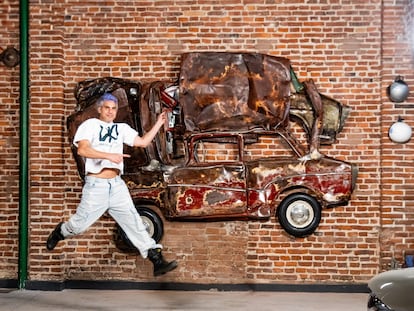
Sign up for our weekly newsletter to get more English-language news coverage from EL PAÍS USA Edition
Tu suscripción se está usando en otro dispositivo
¿Quieres añadir otro usuario a tu suscripción?
Si continúas leyendo en este dispositivo, no se podrá leer en el otro.
FlechaTu suscripción se está usando en otro dispositivo y solo puedes acceder a EL PAÍS desde un dispositivo a la vez.
Si quieres compartir tu cuenta, cambia tu suscripción a la modalidad Premium, así podrás añadir otro usuario. Cada uno accederá con su propia cuenta de email, lo que os permitirá personalizar vuestra experiencia en EL PAÍS.
¿Tienes una suscripción de empresa? Accede aquí para contratar más cuentas.
En el caso de no saber quién está usando tu cuenta, te recomendamos cambiar tu contraseña aquí.
Si decides continuar compartiendo tu cuenta, este mensaje se mostrará en tu dispositivo y en el de la otra persona que está usando tu cuenta de forma indefinida, afectando a tu experiencia de lectura. Puedes consultar aquí los términos y condiciones de la suscripción digital.
More information
Archived In
Últimas noticias
Rowan Atkinson tops Netflix at 70: ‘He’s as funny as ever’
Israeli recognition of Somaliland stirs up the Gulf
Tiger Woods turns 50: Will he continue playing on the PGA Tour or take a back seat?
The surreal journey of James Nnaji, the Barcelona youth player selected in the NBA Draft who ended up in the NCAA
Most viewed
- Oona Chaplin: ‘I told James Cameron that I was living in a treehouse and starting a permaculture project with a friend’
- Reinhard Genzel, Nobel laureate in physics: ‘One-minute videos will never give you the truth’
- Sinaloa Cartel war is taking its toll on Los Chapitos
- Why the price of coffee has skyrocketed: from Brazilian plantations to specialty coffee houses
- Chevy Chase, the beloved comedian who was a monster off camera: ‘Not everyone hated him, just the people who’ve worked with him’
